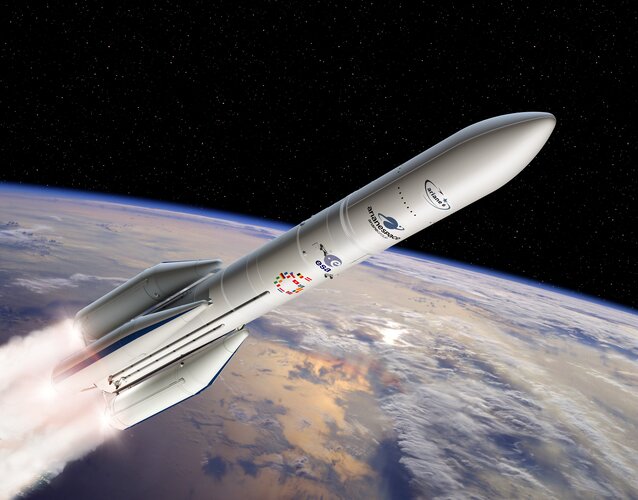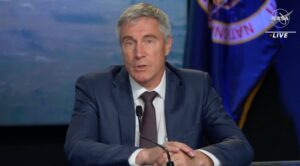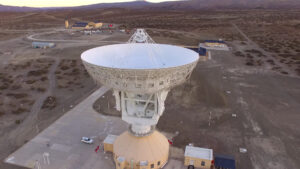UK competition watchdog has concerns about Viasat’s Inmarsat takeover
Thursday, 06 October 2022 15:37
Viasat’s $7.3 billion Inmarsat takeover could lead to more expensive and poorer quality Wi-Fi for plane passengers, the U.K.’s competition watchdog said Oct.
Sierra Space hires former SpaceX executive as CIO
Thursday, 06 October 2022 13:10
Sierra Space has hired a former SpaceX executive as its chief information officer as the company builds up its infrastructure to support work on commercial spacecraft and a space station.
The post Sierra Space hires former SpaceX executive as CIO appeared first on SpaceNews.
Ariane 6 takes next step to first flight with upper stage hot fire tests
Thursday, 06 October 2022 12:00
ESA’s flagship Ariane 6 launch vehicle programme has taken a dramatic step towards first flight with the start of a series of hot fire tests of the rocket’s upper stage and its all-new Vinci engine.
Roscosmos official supports continued cooperation with NASA on ISS
Thursday, 06 October 2022 11:33
After a successful launch of a Crew Dragon spacecraft whose crew included a Russian cosmonaut, a Roscosmos official struck a more conciliatory tone about relations with NASA.
The post Roscosmos official supports continued cooperation with NASA on ISS appeared first on SpaceNews.
Report highlights U.S. concerns over China’s space infrastructure in South America
Thursday, 06 October 2022 11:09
The expansion of Chinese ground stations in South America is generating concern regarding Beijing’s intentions in the region and in space, according to a new report.
The post Report highlights U.S.
SpaceX's Crew 5 mission blasts off to ISS with Russian cosmonaut onboard
Thursday, 06 October 2022 10:14 NASA and SpaceX's Crew 5 mission lifted off from Cape Canaveral Space Force Station in Florida at noon EDT on Wednesday and is on its way to the International Space Station.
The crew, which includes NASA astronauts Nicole Mann and Josh Cassada, Japanese astronaut Koichi Wakata and Russian cosmonaut Anna Kikina, are scheduled to work aboard the space station for six months.
SpaceX
NASA and SpaceX's Crew 5 mission lifted off from Cape Canaveral Space Force Station in Florida at noon EDT on Wednesday and is on its way to the International Space Station.
The crew, which includes NASA astronauts Nicole Mann and Josh Cassada, Japanese astronaut Koichi Wakata and Russian cosmonaut Anna Kikina, are scheduled to work aboard the space station for six months.
SpaceX Swedish space instrument will study the Moon on board a Turkish spacecraft
Thursday, 06 October 2022 10:14 A space instrument from the Swedish Institute of Space Physics (IRF) will be sent to the Moon within the next few years onboard the Turkish spacecraft AYAP-1. In orbit around the Moon, the Lunar Neutrals Telescope will study how the flow of charged particles from the Sun, the solar wind, interacts with the Moon's surface.
The agreement between IRF and the Turkish Space Technologies Researc
A space instrument from the Swedish Institute of Space Physics (IRF) will be sent to the Moon within the next few years onboard the Turkish spacecraft AYAP-1. In orbit around the Moon, the Lunar Neutrals Telescope will study how the flow of charged particles from the Sun, the solar wind, interacts with the Moon's surface.
The agreement between IRF and the Turkish Space Technologies Researc Virgin Orbit's next rocket ready for Cornwall
Thursday, 06 October 2022 10:14 Virgin Orbit (Nasdaq: VORB), a leading responsive launch provider, reports that its latest rocket has completed a full launch rehearsal and is now ready for flight. The window for the company's next launch, planned to be the first orbital space launch from the U.K., will be determined by the launch permitting regulatory process.
This rehearsal marked the final major acceptance test of the
Virgin Orbit (Nasdaq: VORB), a leading responsive launch provider, reports that its latest rocket has completed a full launch rehearsal and is now ready for flight. The window for the company's next launch, planned to be the first orbital space launch from the U.K., will be determined by the launch permitting regulatory process.
This rehearsal marked the final major acceptance test of the Ad-block this: Advertisers ready to hit you with commercials from space
Thursday, 06 October 2022 10:14 Researchers from Skoltech and MIPT have studied the economic feasibility of a space advertising mission that would launch a formation of satellites into orbit to reflect sunlight and display commercials in the sky above cities. Published in the journal Aerospace, the study considers such factors as satellite fuel consumption, target city population, local advertising costs, and many more, arrivi
Researchers from Skoltech and MIPT have studied the economic feasibility of a space advertising mission that would launch a formation of satellites into orbit to reflect sunlight and display commercials in the sky above cities. Published in the journal Aerospace, the study considers such factors as satellite fuel consumption, target city population, local advertising costs, and many more, arrivi Tiangong space station marks key step in assembly
Thursday, 06 October 2022 10:14 The Wentian lab module of China's Tiangong space station has been repositioned to dock with a radial port on the station's Tianhe core module on Friday afternoon, which marked a key step in Tiangong's in-orbit assembly, according to the China Manned Space Agency.
The agency said in a news release that during the hour-long operation that finished at 12:44 pm, Wentian was moved from the axia
The Wentian lab module of China's Tiangong space station has been repositioned to dock with a radial port on the station's Tianhe core module on Friday afternoon, which marked a key step in Tiangong's in-orbit assembly, according to the China Manned Space Agency.
The agency said in a news release that during the hour-long operation that finished at 12:44 pm, Wentian was moved from the axia Sols 3614-3615: Chemin's Moment To Shine
Thursday, 06 October 2022 10:14 The Curiosity team continues with our "Canaima" drill campaign. [Today's] 2-sol plan will provide our first look at the minerals present within this sample. This is complementary but different than the chemical compositions provided by ChemCam and APXS before we drilled. CheMin uses X-ray diffraction to confirm crystalline mineralogy, they direct a beam of X-rays, as fine as a human hair, throug
The Curiosity team continues with our "Canaima" drill campaign. [Today's] 2-sol plan will provide our first look at the minerals present within this sample. This is complementary but different than the chemical compositions provided by ChemCam and APXS before we drilled. CheMin uses X-ray diffraction to confirm crystalline mineralogy, they direct a beam of X-rays, as fine as a human hair, throug SwRI creates Space Sector with two new divisions to support space research and development
Thursday, 06 October 2022 10:14 Southwest Research Institute's Space Science and Engineering Division, with 465 employees in three states, has been restructured to create two new technical divisions. Dr. James L. Burch, vice president of the Space Science Division, will become Senior Vice President leading SwRI's new Space Sector organization, encompassing all three divisions.
Dr. Robin Canup will lead the new Solar Syst
Southwest Research Institute's Space Science and Engineering Division, with 465 employees in three states, has been restructured to create two new technical divisions. Dr. James L. Burch, vice president of the Space Science Division, will become Senior Vice President leading SwRI's new Space Sector organization, encompassing all three divisions.
Dr. Robin Canup will lead the new Solar Syst Africa in space: continent has a lot to gain, but proper plans must be put in place
Thursday, 06 October 2022 10:14 Every year in October nearly 100 countries organise activities to mark World Space Week. The theme this year is space and sustainability. In this interview, Adejuwon Soyinka, West Africa regional editor at The Conversation Africa, asks Etim Offiong about how far Africa has come in the space age and what benefits the continent stands to gain from its investment in space technology.
Russia's
Every year in October nearly 100 countries organise activities to mark World Space Week. The theme this year is space and sustainability. In this interview, Adejuwon Soyinka, West Africa regional editor at The Conversation Africa, asks Etim Offiong about how far Africa has come in the space age and what benefits the continent stands to gain from its investment in space technology.
Russia's The fountain of life: Water droplets hold the secret ingredient for building life
Thursday, 06 October 2022 10:14 Purdue University chemists have uncovered a mechanism for peptide-forming reactions to occur in water - something that has puzzled scientists for decades.
"This is essentially the chemistry behind the origin of life," said Graham Cooks, the Henry Bohn Hass Distinguished Professor of Analytical Chemistry in Purdue's College of Science."This is the first demonstration that primordial molecu
Purdue University chemists have uncovered a mechanism for peptide-forming reactions to occur in water - something that has puzzled scientists for decades.
"This is essentially the chemistry behind the origin of life," said Graham Cooks, the Henry Bohn Hass Distinguished Professor of Analytical Chemistry in Purdue's College of Science."This is the first demonstration that primordial molecu Supercomputer simulations reveal new possibilities for the Moon's origin
Thursday, 06 October 2022 10:14 Our pioneering scientists from the Institute for Computational Cosmology used supercomputer simulations to reveal an alternate explanation for the Moon's origin, as a satellite placed immediately into orbit following a giant impact between Earth and a Mars-sized body.
The researchers created the highest resolution simulations yet produced to study the Moon's origin 4.5 billion years ago.
Our pioneering scientists from the Institute for Computational Cosmology used supercomputer simulations to reveal an alternate explanation for the Moon's origin, as a satellite placed immediately into orbit following a giant impact between Earth and a Mars-sized body.
The researchers created the highest resolution simulations yet produced to study the Moon's origin 4.5 billion years ago. 
